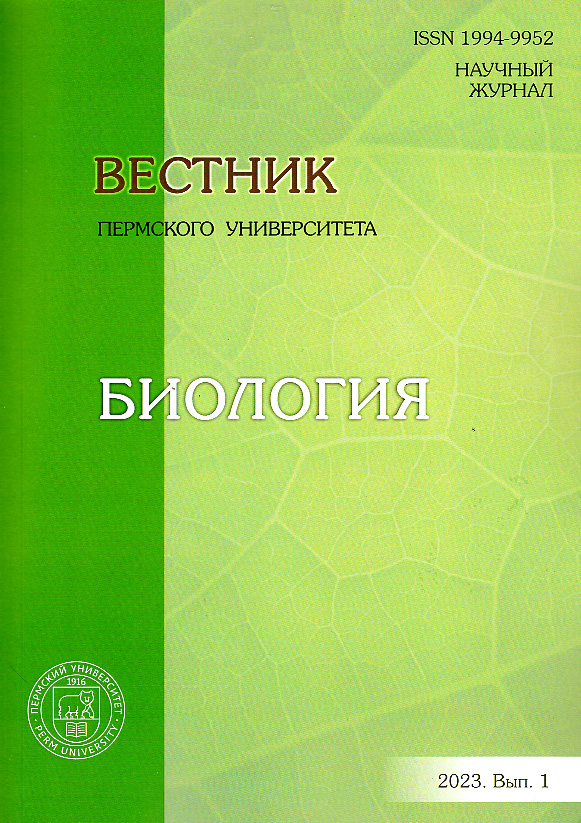Expression of cadaverine biosynthesis genes under superoxide oxidative stress
Main Article Content
Abstract
Article Details
References
Akhova A. et al. Cadaverine biosynthesis contributes to decreased Escherichia coli susceptibility to anti-biotics // Research in Microbiology. 2021. Vol. 172. P. 103881. DOI: 10.1016/j.resmic.2021.103881.
Ding H., Demple B. Direct nitric oxide signal transduction via nitrosylation of iron-sulfur centers in the SoxR transcription activator // Proceeding of the National Academy of Sciences of the USA. 2000. Vol. 97. P. 5146–5150. DOI: 10.1073/pnas.97.10.5146.
Felix J. et al. Structural and functional analysis of the Francisella lysine decarboxylase as a key actor in oxidative stress resistance // Scientific Reports. 2021. Vol. 11. P. 972. DOI: 10.1038/s41598-020-79611-5.
Gu M., Imlay J.A. The SoxRS response of Escherichia coli is directly activated by redox-cycling drugs ra-ther than by superoxide // Molecular Microbiology. 2011. Vol. 79. P. 136–150. DOI: 10.1111/j.1365-2958.2010.07520.x.
Hidalgo E. et al. Binuclear [2Fe-2S] clusters in the Escherichia coli SoxR protein and role of the metal centers in transcription // Journal of Biological Chemistry. 1995. Vol. 270. P. 20908–20914. DOI: 10.1074/jbc.270.36.20908.
Kim J.S., Choi S.H., Lee J.K. Lysine decarboxylase expression by Vibrio vulnificus is induced by SoxR in response to superoxide stress // Journal of Bacteriology. 2006. Vol. 188. P. 8586–8592. DOI: 10.1128/JB.01084-06.
Kobayashi K., Tagawa S. Isolation of reductase for SoxR that governs an oxidative response regulon from Escherichia coli // FEBS Letters. 1999. Vol. 451. P. 227–230. DOI: 10.1016/s0014-5793(99)00565-7.
Krapp A.R., Humbert M.V., Carrillo N. The soxRS response of Escherichia coli can be induced in the ab-sence of oxidative stress and oxygen by modulation of NADPH content // Microbiology (Reading). 2011. Vol. 157. P. 957–965. DOI: 10.1099/mic.0.039461-0.
Liochev S.I. et al. Induction of the soxRS regulon of Escherichia coli by superoxide // Journal of Biologi-cal Chemistry. 1999. Vol. 274. P. 9479–9481. DOI: 10.1074/jbc.274.14.9479.
Martin R.G., Gillette W.K., Rosner J.L. Promoter discrimination by the related transcriptional activators MarA and SoxS: differential regulation by differential binding // Molecular Microbiology. 2000. Vol. 35. P. 623–634. DOI: 10.1046/j.1365-2958.2000.01732.x.
Michael A.J. Polyamines in Eukaryotes, Bacteria, and Archaea // Journal of Biological Chemistry. 2016. Vol. 291. P. 14896–14903. DOI: 10.1074/jbc.R116.734780.
Miller H.J. Experiments in molecular genetics. Cold Spring Harbor: Cold Spring Harbor Laboratory, 1972. 466 p.
Nunoshiba T. et al. Two-stage control of an oxidative stress regulon: the Escherichia coli SoxR protein triggers redox-inducible expression of the soxS regulatory gene // Journal of Bacteriology. 1992. Vol. 174. P. 6054–6060. DOI: 10.1128/jb.174.19.6054-6060.1992.
Rhee H.J., Kim E.J., Lee J.K. Physiological polyamines: simple primordial stress molecules // Journal of Cellular and Molecular Medicine. 2007. Vol. 11. P. 685–703. DOI: 10.1111/j.1582-4934.2007.00077.x.
Seixas A.F. et al. Bacterial response to oxidative stress and RNA oxidation // Frontiers in Genetics. 2022. Vol. 12. P. 821535. DOI: 10.3389/fgene.2021.821535.
Tkachenko A.G. Mechanisms of protective functions of Escherichia coli polyamines against toxic ef-fect of paraquat, which causes superoxide stress // Biochemistry (Mosc). 2004. Vol. 69. P. 188–194. DOI: 10.1023/b:biry.0000018950.30452.53.
Wu J., Weiss B. Two-stage induction of the soxRS (superoxide response) regulon of Escherichia coli // Journal of Bacteriology. 1992. Vol. 174. P. 3915–3920. DOI: 10.1128/jb.174.12.3915-3920.1992.
Yamamoto Y. et al. The Escherichia coli ldcC gene encodes another lysine decarboxylase, probably a constitutive enzyme // Genes and Genetic Systems. 1997. Vol. 72. P. 167–172. DOI: 10.1266/ggs.72.167.




